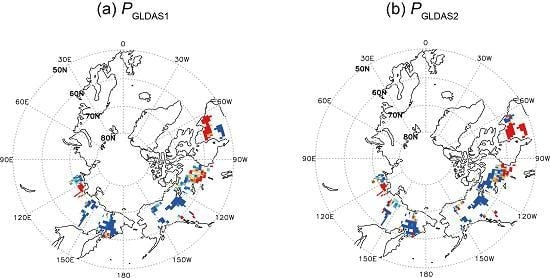Hydrological Variability and Changes in the Arctic Circumpolar Tundra and the Three Largest Pan-Arctic River Basins from 2002 to 2016
Abstract
:1. Introduction
2. Materials and Methods
2.1. Study Area
2.2. Data
2.2.1. Satellite Data
2.2.2. Reanalysis Data
2.2.3. River Flow Rate Data (R)
2.3. Theory
2.4. Analysis
2.4.1. TWS Changes Across the Arctic Circumpolar Tundra Region
2.4.2. TWS Changes Among the Three River Basins
3. Results
3.1. TWS in the Arctic Circumpolar Tundra
3.1.1. Temporal Variations in the TWS in the ACTR
3.1.2. Precipitation, Evapotranspiration, and Air Temperature from GLDAS
3.1.3. TWSGRACE versus Ta, P, and E
3.1.4. Regional Trends in TWS, P, and E
3.2. Whole Basin-Scale Variabilities in the TWS for Three Arctic Rivers
3.2.1. Temporal Variations
3.2.2. Monthly Mean P and R
3.2.3. Relationship between the TWS and Runoff in the Lena and Mackenzie River Basins
4. Discussion
4.1. Hydrological Changes in the Tundra Throughout the ACTR
4.2. Whole Basin-Scale Hydrological Changes
4.3. Inconsistencies between GLDAS1 and GLDAS2
5. Conclusions
- The negative trend in the TWS throughout the ACTR was primarily driven by evapotranspiration. Meanwhile, precipitation has a minor impact on the TWS.
- In terms of regional changes in the TWS, a large and significant negative trend in the TWS can be observed mainly over the North American continent, including the region along the Gulf of Alaska and the Northwestern Territory of Canada. Meanwhile, the negative trends in the TWS over the Eurasian continent were weaker than those over the North American continent.
- The comparison of R with TWS among the three river basins reveals strong positive correlations for the Lena River and Mackenzie River basins, but no significant correlation for the Yukon River basin, where TWS was sensitive to the changes in EGLDAS2. This confirms E as a driving factor in the decline in TWS, even on the scale of the whole basin.
- The TWS among the three river basins was further controlled by the presence of continuous permafrost. For example, the autumnal TWS in the Lena River Basin (which exhibits continuous permafrost) persisted through the spring of the following year. However, no such effect was observed in the Mackenzie River catchment, which is partially covered in both continuous permafrost and discontinuous permafrost.
- The GLDAS2-based products corresponded better with the spatiotemporal variability in TWSGRACE than the GLDAS1-based products. GLDAS2 is likely more suitable for analyzing hydrological changes in Arctic regions than GLDAS1.
Supplementary Materials
Acknowledgments
Author Contributions
Conflicts of Interest
References
- Serreze, M.C.; Barrett, A.P.; Slater, A.G.; Woodgate, R.A.; Aagaard, K.; Lammers, R.B.; Steele, M.; Moritz, R.; Meredith, M.; Lee, C.M. The large-scale freshwater cycle of the arctic. J. Geophys. Res. Oceans 2006, 111. [Google Scholar] [CrossRef]
- Chapin, F.S., III; Sturm, M.; Serreze, M.C.; McFadden, J.P.; Key, J.R.; Lloyd, A.H.; McGuire, A.D.; Rupp, T.S.; Lynch, A.H.; Schimel, J.P.; et al. Role of land-surface changes in Arctic summer warming. Science 2005, 310, 657–660. [Google Scholar] [CrossRef] [PubMed]
- Peterson, B.J.; Holmes, R.M.; McClelland, J.W.; Vörösmarty, C.J.; Lammers, R.B.; Shiklomanov, A.I.; Shiklomanov, I.A.; Rahmstorf, S. Increasing river discharge to the Arctic ocean. Science 2002, 298, 2171–2173. [Google Scholar] [CrossRef] [PubMed]
- Shiklomanov, A.I.; Lammers, R.B. Record Russian river discharge in 2007 and the limits of analysis. Environ. Res. Lett. 2009, 4, 045015. [Google Scholar] [CrossRef]
- Rawlins, M.A.; Ye, H.; Yang, D.; Shiklomanov, A.; McDonald, K.C. Divergence in seasonal hydrology across northern Eurasia: Emerging trends and water cycle linkages. J. Geophys. Res. Atmos. 2009, 114. [Google Scholar] [CrossRef]
- Willmott, C.J.; Matsuura, K. Terrestrial Air Temperature and Precipitation: Monthly and Annual Time Series. Available online: http://climate.geog.udel.edu/~climate/html_pages/README.ghcn_ts2.html (accessed on 17 November 2017).
- St Jacques, J.-M.; Sauchyn, D.J. Increasing winter baseflow and mean annual streamflow from possible permafrost thawing in the Northwest Territories, Canada. Geophys. Res. Lett. 2009, 36, 53–56. [Google Scholar] [CrossRef]
- Quinton, W.L.; Hayashi, M.; Pietroniro, A. Connectivity and storage functions of channel fens and flat bogs in northern basins. Hydrol. Process. 2003, 17, 3665–3684. [Google Scholar] [CrossRef]
- Papa, F.; Prigent, C.; Rossow, W.B. Monitoring flood and discharge variations in the large Siberian rivers from a multi-satellite technique. Surv. Geophys. 2008, 29, 297–317. [Google Scholar] [CrossRef]
- Hood, J.L.; Hayashi, M. Characterization of snowmelt flux and groundwater storage in an Alpine headwater basin. J. Hydrol. 2015, 521, 482–497. [Google Scholar] [CrossRef]
- Huang, J.; Yu, H.; Guan, X.; Wang, G.; Guo, R. Accelerated dryland expansion under climate change. Nat. Clim. Chang. 2015, 6, 166–171. [Google Scholar] [CrossRef]
- Suzuki, K.; Matsuo, K.; Hiyama, T. Satellite gravimetry-based analysis of terrestrial water storage and its relationship with run-off from the Lena River in Eastern Siberia. Int. J. Remote Sens. 2016, 37, 2198–2210. [Google Scholar] [CrossRef]
- Nitze, I.; Grosse, G.; Jones, B.M.; Arp, C.D.; Ulrich, M.; Federov, A.; Veremeeva, A. Landsat-based trend analysis of lake dynamics across northern Permafrost regions. Remote Sens. 2017, 9, 640. [Google Scholar] [CrossRef]
- Iijima, Y.; Fedorov, A.N.; Park, H.; Suzuki, K.; Yabuki, H.; Maximov, T.C.; Ohata, T. Abrupt increases in soil temperatures following increased precipitation in a Permafrost region, Central Lena river basin, Russia. Permafr. Periglac. Process. 2010, 21, 30–41. [Google Scholar] [CrossRef]
- Walvoord, M.A.; Kurylyk, B.L. Hydrologic impacts of thawing permafrost—A review. Vadose Zone J. 2016, 15. [Google Scholar] [CrossRef]
- Ferrians, O.J., Jr.; Heginbottom, J.A.; Melnikov, E.S. Circum-Arctic Map of Permafrost and Ground-Ice Conditions (Version 2); National Snow and Ice Data Center: Boulder, CO, USA, 2002. [Google Scholar]
- Sakumura, C.; Bettadpur, S.; Bruinsma, S. Ensemble prediction and intercomparison analysis of grace time-variable gravity field models. Geophys. Res. Lett. 2014, 41, 1389–1397. [Google Scholar] [CrossRef]
- Wahr, J.; Molenaar, M.; Bryan, F. Time variability of the earth’s gravity field: Hydrological and oceanic effects and their possible detection using grace. J. Geophys. Res. Solid Earth 1998, 103, 30205–30229. [Google Scholar] [CrossRef]
- Swenson, S.; Chambers, D.; Wahr, J. Estimating geocenter variations from a combination of grace and ocean model output. J. Geophys. Res. Solid Earth 2008, 113. [Google Scholar] [CrossRef]
- Cheng, M.; Tapley, B.D. Variations in the earth’s oblateness during the past 28 years. J. Geophys. Res. Solid Earth 2004, 109. [Google Scholar] [CrossRef]
- Velicogna, I.; Tong, J.; Zhang, T.; Kimball, J.S. Increasing subsurface water storage in discontinuous permafrost areas of the Lena river basin, Eurasia, detected from grace. Geophys. Res. Lett. 2012, 39. [Google Scholar] [CrossRef]
- Geruo, A.; Wahr, J.; Zhong, S. Computations of the viscoelastic response of a 3-D compressible earth to surface loading: An application to glacial isostatic adjustment in Antarctica and Canada. Geophys. J. Int. 2013, 192, 557–572. [Google Scholar] [CrossRef]
- Wahr, J.; Swenson, S.; Velicogna, I. Accuracy of GRACE mass estimates. Geophys. Res. Lett. 2006, 33, 30205–30255. [Google Scholar] [CrossRef]
- Thompson, R.E.; Emery, W.J. Data Analysis Method in Physical Oceanography, 3rd ed.; Elsevier: Boston, MA, USA, 2014; p. 716. [Google Scholar]
- Wang, W.; Cui, W.; Wang, X.; Chen, X. Evaluation of GLDAS-1 and GLDAS-2 forcing data and Noah model simulations over China at the monthly scale. J. Hydrometeorol. 2016, 17, 2815–2833. [Google Scholar] [CrossRef]
- Rodell, M.; Houser, P.R.; Jambor, U.; Gottschalck, J.; Mitchell, K.; Meng, C.J.; Arsenault, K.; Cosgrove, B.; Radakovich, J.; Bosilovich, M.; et al. The global land data assimilation system. Bull. Am. Meteorol. Soc. 2004, 85, 381–394. [Google Scholar] [CrossRef]
- Koren, V.; Schaake, J.; Mitchell, K.; Duan, Q.Y.; Chen, F.; Baker, J.M. A parameterization of snowpack and frozen ground intended for NCEP weather and climate models. J. Geophys. Res. Atmos. 1999, 104, 19569–19585. [Google Scholar] [CrossRef]
- Dai, Y.; Zeng, X.; Dickinson, R.E.; Baker, I.; Bonan, G.B.; Bosilovich, M.G.; Denning, A.S.; Dirmeyer, P.A.; Houser, P.R.; Niu, G.; et al. The common land model. Bull. Am. Meteorol. Soc. 2003, 84, 1013–1023. [Google Scholar] [CrossRef]
- Liang, X.; Lettenmaier, D.P.; Wood, E.F.; Burges, S.J. A simple hydrologically based model of land surface water and energy fluxes for general circulation models. J. Geophys. Res. Atmos. 1994, 99, 14415–14428. [Google Scholar] [CrossRef]
- Koster, R.D.; Suarez, M.J.; Climate and Radiation Branch, Goddard Space Flight Center, Laboratory for Atmospheres. Energy and Water Balance Calculations in the Mosaic LSM; Data Assimilation Office, Laboratory for Hydrospheric Processes, National Aeronautics and Space Administration: Greenbelt, MD, USA, 1996.
- Sheffield, J.; Goteti, G.; Wood, E.F. Development of a 50-year high-resolution global dataset of meteorological forcings for land surface modeling. J. Clim. 2006, 19, 3088–3111. [Google Scholar] [CrossRef]
- Makarieva, O.; Tananaev, N.; Lebedeva, L. Arctic Hydrology and Statistics for the Lena River Basin. Compilative Dataset on Mean Annual and Extreme Flows in the Lena River Basin, version 1.1; Makarieva, O., Tananaev, N., Lebedeva, L., Eds.; Figshare: London, UK, 2016. [Google Scholar] [CrossRef]
- Tananaev, N.I.; Makarieva, O.M.; Lebedeva, L.S. Trends in annual and extreme flows in the Lena river basin, northern Eurasia. Geophys. Res. Lett. 2016, 43, 10764–10772. [Google Scholar] [CrossRef]
- Ichii, K.; Kondo, M.; Okabe, Y.; Ueyama, M.; Kobayashi, H.; Lee, S.-J.; Saigusa, N.; Zhu, Z.; Myneni, R. Recent Changes in Terrestrial Gross Primary Productivity in Asia from 1982 to 2011. Remote Sens. 2013, 5, 6043–6062. [Google Scholar] [CrossRef]
- Kendall, M.G. A new measure of rank correlation. Biometrika 1938, 30, 81–93. [Google Scholar] [CrossRef]
- Sokal, R.R.; Rohlf, F.J. Biometry: The Principles and Practice of Statistics in Biological Research, 3rd ed.; W.H. Freeman: New York, NY, USA, 1995; p. 539. [Google Scholar]
- Suzuki, K.; Kubota, J.; Ohata, T.; Vuglinsky, V. Influence of snow ablation and frozen ground on spring runoff generation in the mogot experimental watershed, southern mountainous Taiga of eastern Siberia. Hydrol. Res. 2006, 37, 21–29. [Google Scholar] [CrossRef]
- Suzuki, K. Estimation of snowmelt infiltration into frozen ground and snowmelt runoff in the mogot experimental watershed in east Siberia. Int. J. Geosci. 2013, 4, 1346–1354. [Google Scholar] [CrossRef]
- Muskett, R.R.; Romanovsky, V.E. Groundwater storage changes in Arctic Permafrost watersheds from grace and in situ measurements. Environ. Res. Lett. 2009, 4, 045009. [Google Scholar] [CrossRef]
- Cook, B.I.; Smerdon, J.E.; Seager, R.; Coats, S. Global warming and 21st century drying. Clim. Dyn. 2014, 43, 2607–2627. [Google Scholar] [CrossRef]
- Boike, J.; Kattenstroth, B.; Abramova, K.; Bornemann, N.; Chetverova, A.; Fedorova, I.; Fröb, K.; Grigoriev, M.; Grüber, M.; Kutzbach, L.; et al. Baseline characteristics of climate, permafrost and land cover from a new permafrost observatory in the Lena River Delta, Siberia (1998-2011). Biogeosciences 2013, 10, 2105–2128. [Google Scholar] [CrossRef] [Green Version]
- Whan, K.; Zscheischler, J.; Orth, R.; Shongwe, M.; Rahimi, M.; Asare, E.O.; Seneviratne, S.I. Impact of soil moisture on extreme maximum temperatures in Europe. Weather Clim. Extrem. 2015, 9, 57–67. [Google Scholar] [CrossRef]
- Fu, Q.; Feng, S. Responses of terrestrial aridity to global warming. J. Geophys. Res. Atmos. 2014, 119, 7863–7875. [Google Scholar] [CrossRef]
- Riordan, B.; Verbyla, D.; McGuire, A.D. Shrinking ponds in subarctic Alaska based on 1950–2002 remotely sensed images. J. Geophys. Res. Biogeosci. 2006, 111. [Google Scholar] [CrossRef]
- Yoshikawa, K.; Hinzman, L.D. Shrinking thermokarst ponds and groundwater dynamics in discontinuous permafrost near council, Alaska. Permafr. Periglac. Process. 2003, 14, 151–160. [Google Scholar] [CrossRef]
- Lantz, T.C.; Turner, K.W. Changes in lake area in response to thermokarst processes and climate in old crow flats, Yukon. J. Geophys. Res. Biogeosci. 2015, 120, 513–524. [Google Scholar] [CrossRef]
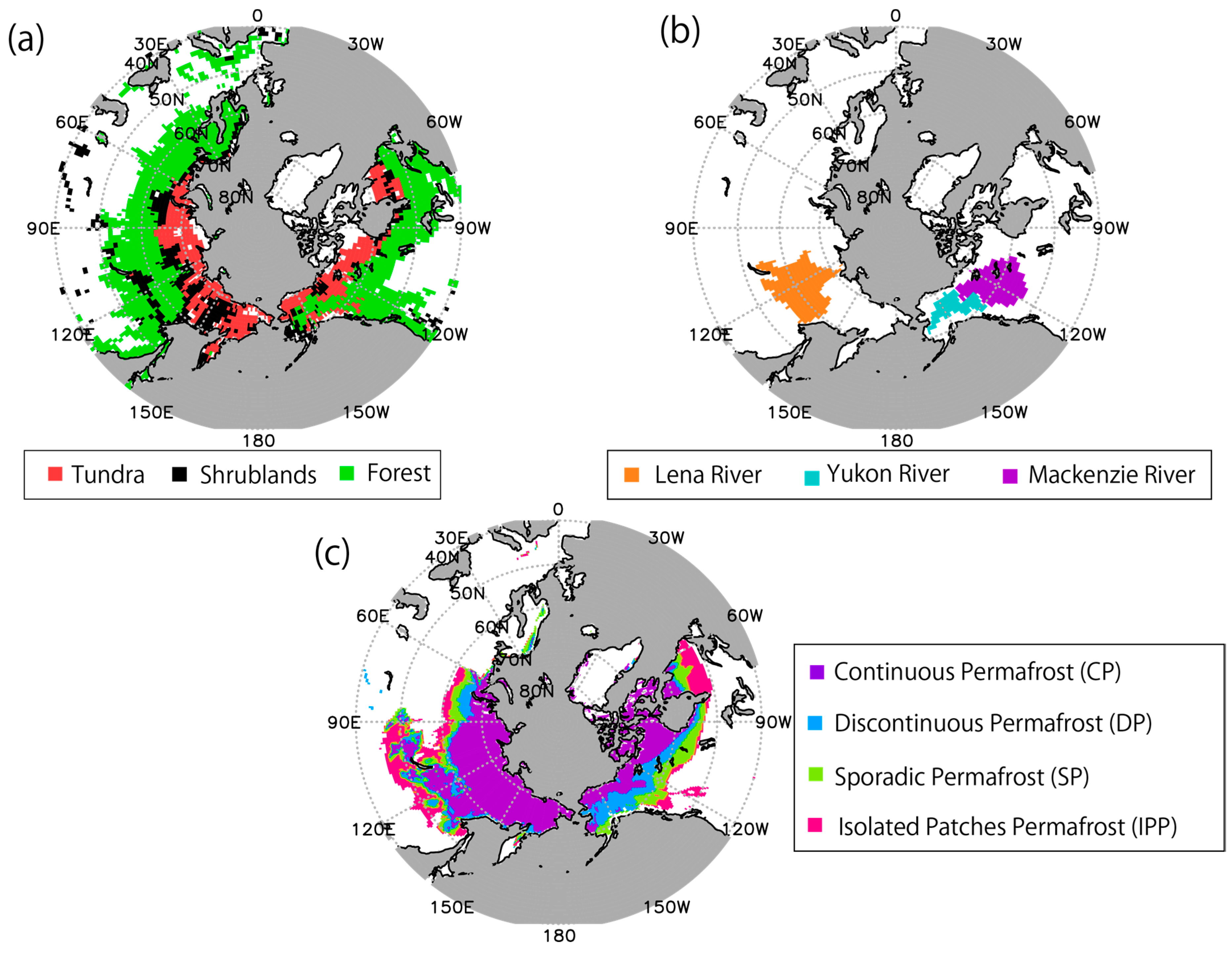
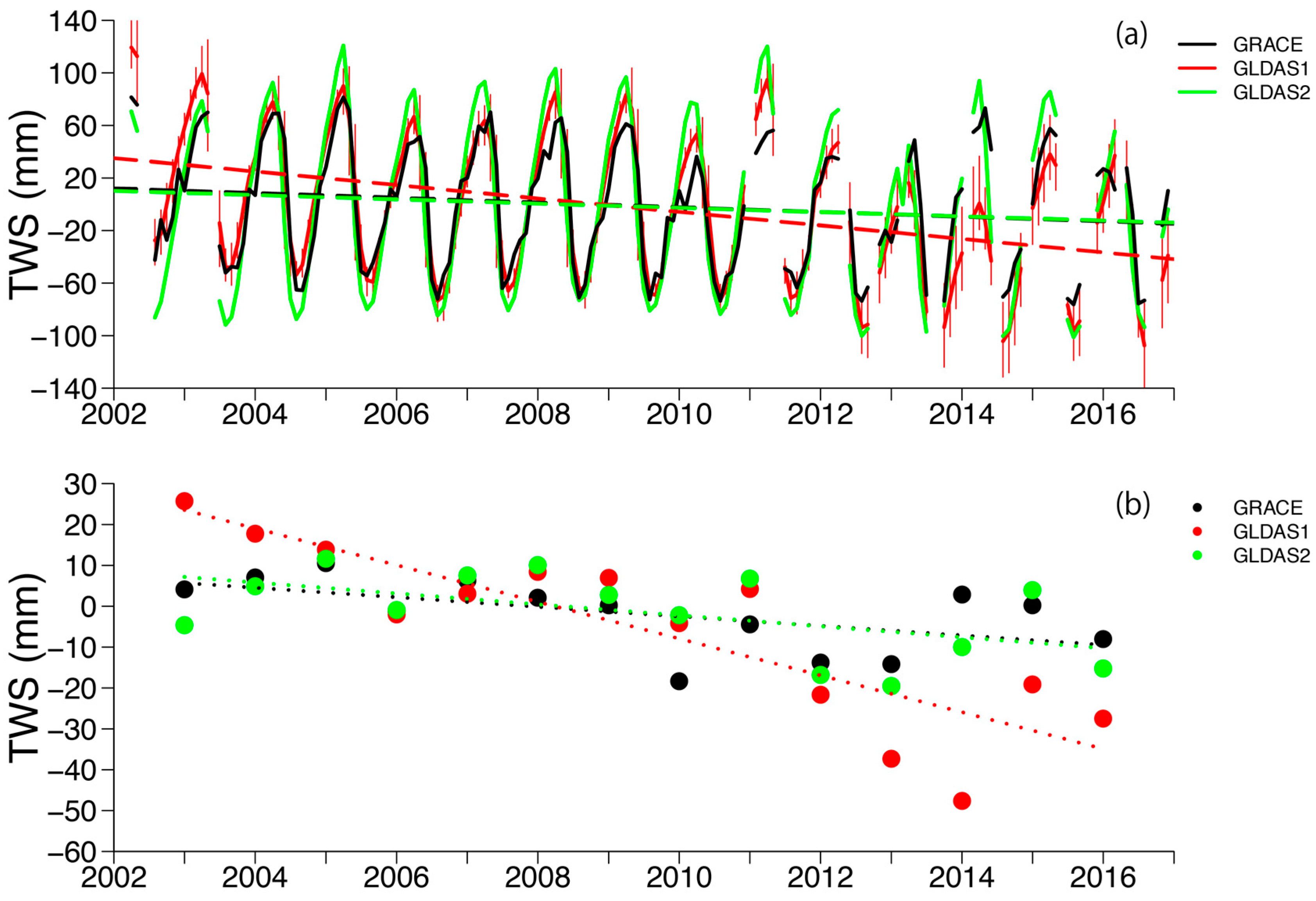
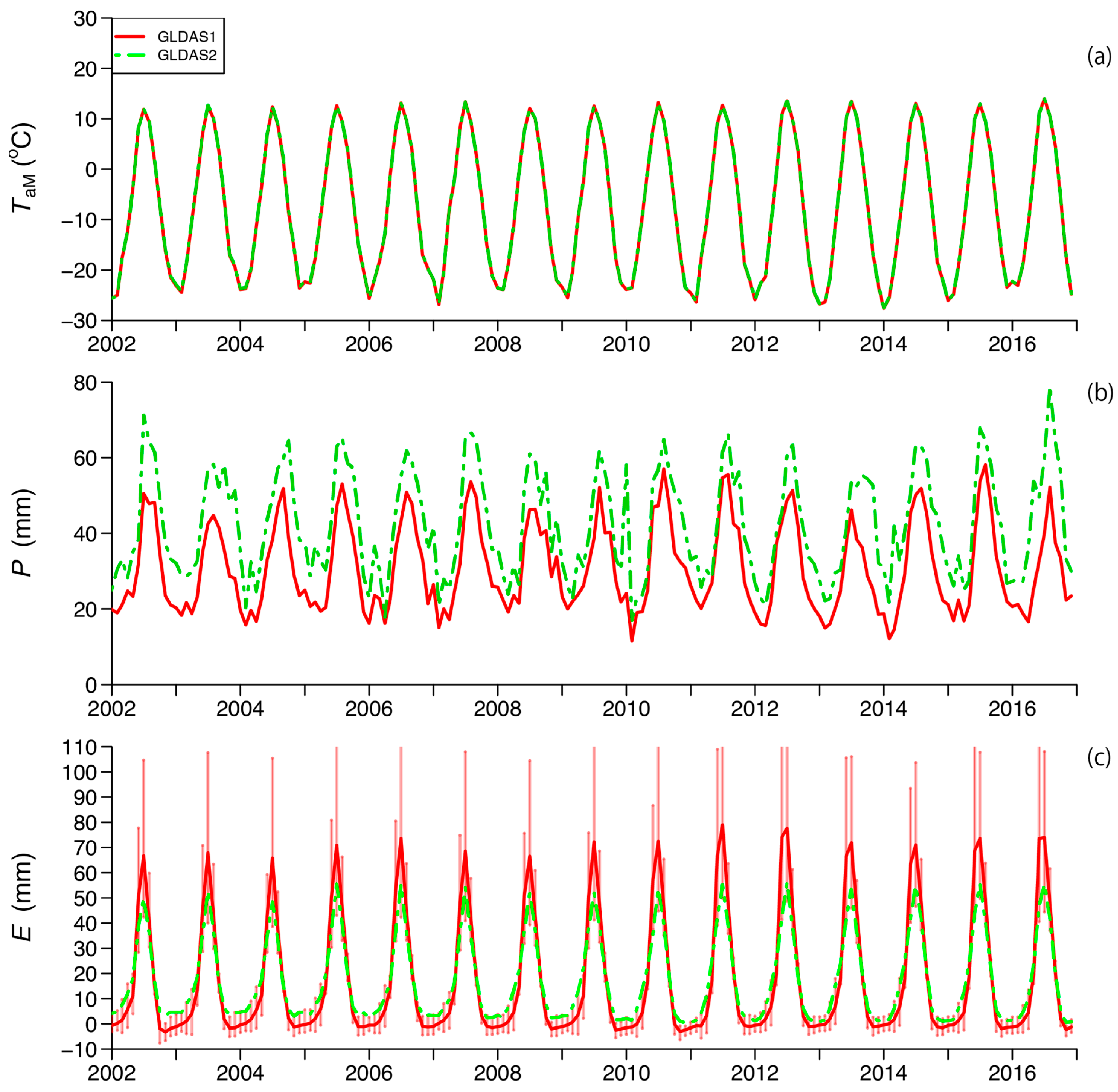

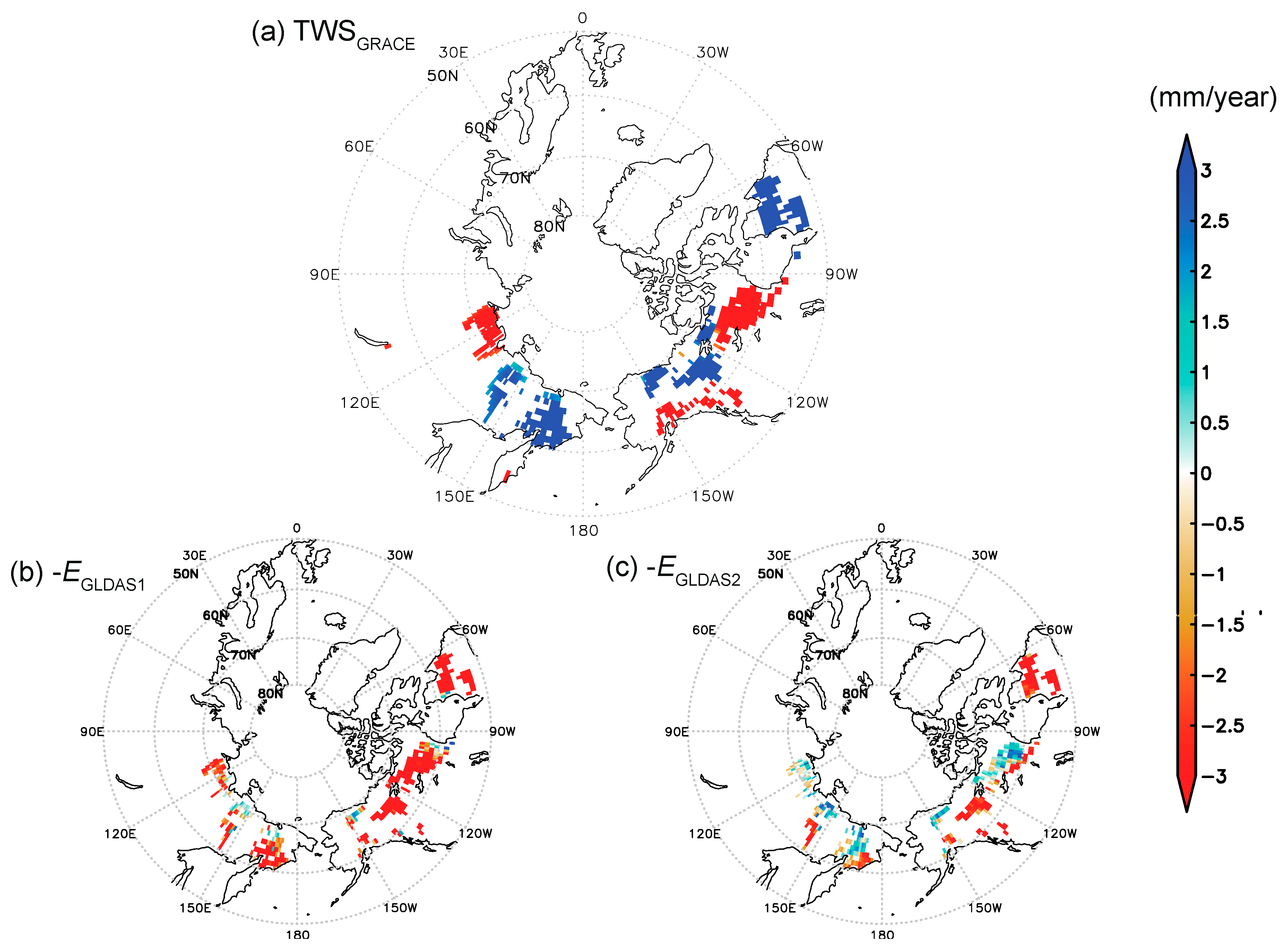
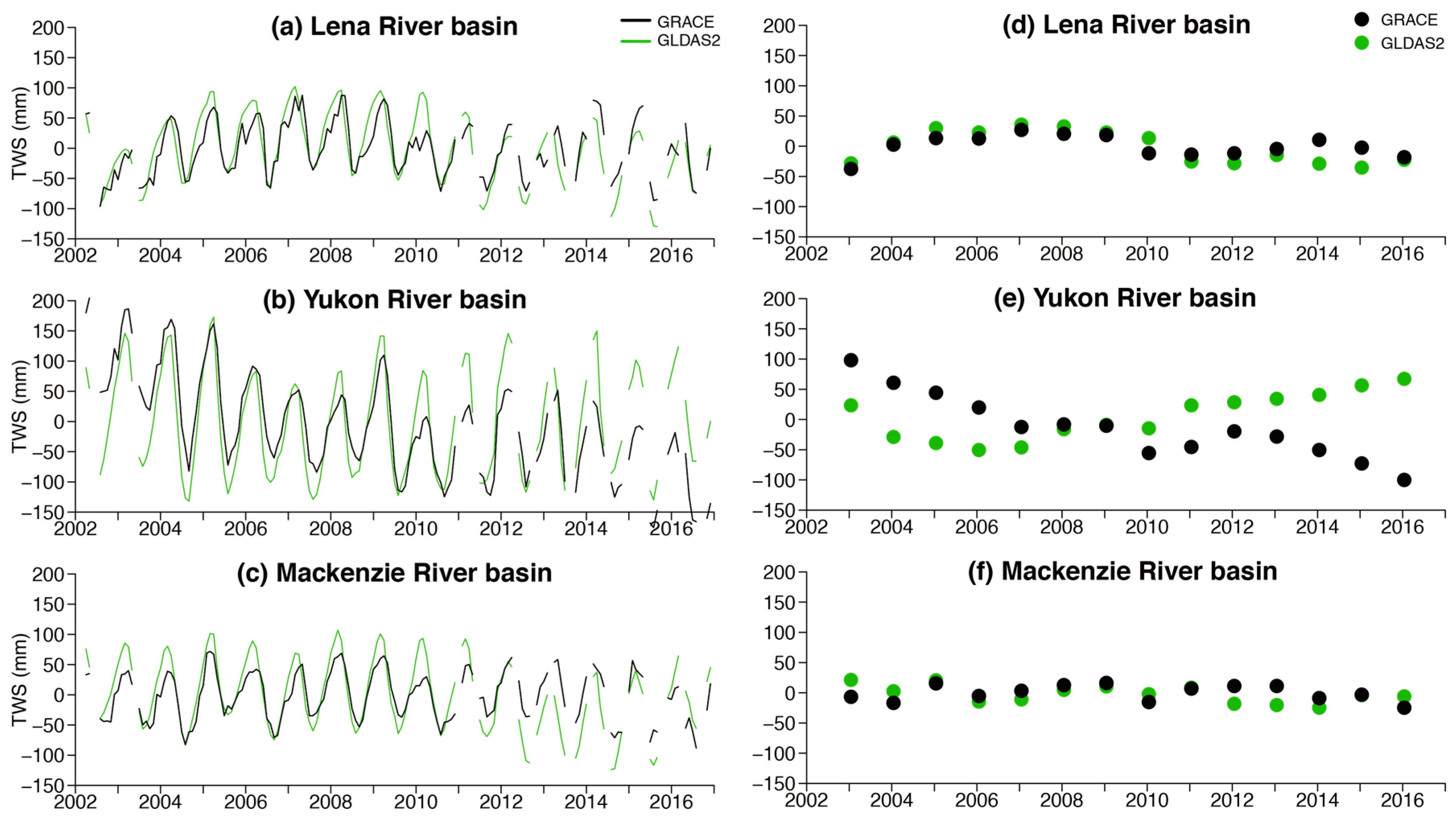
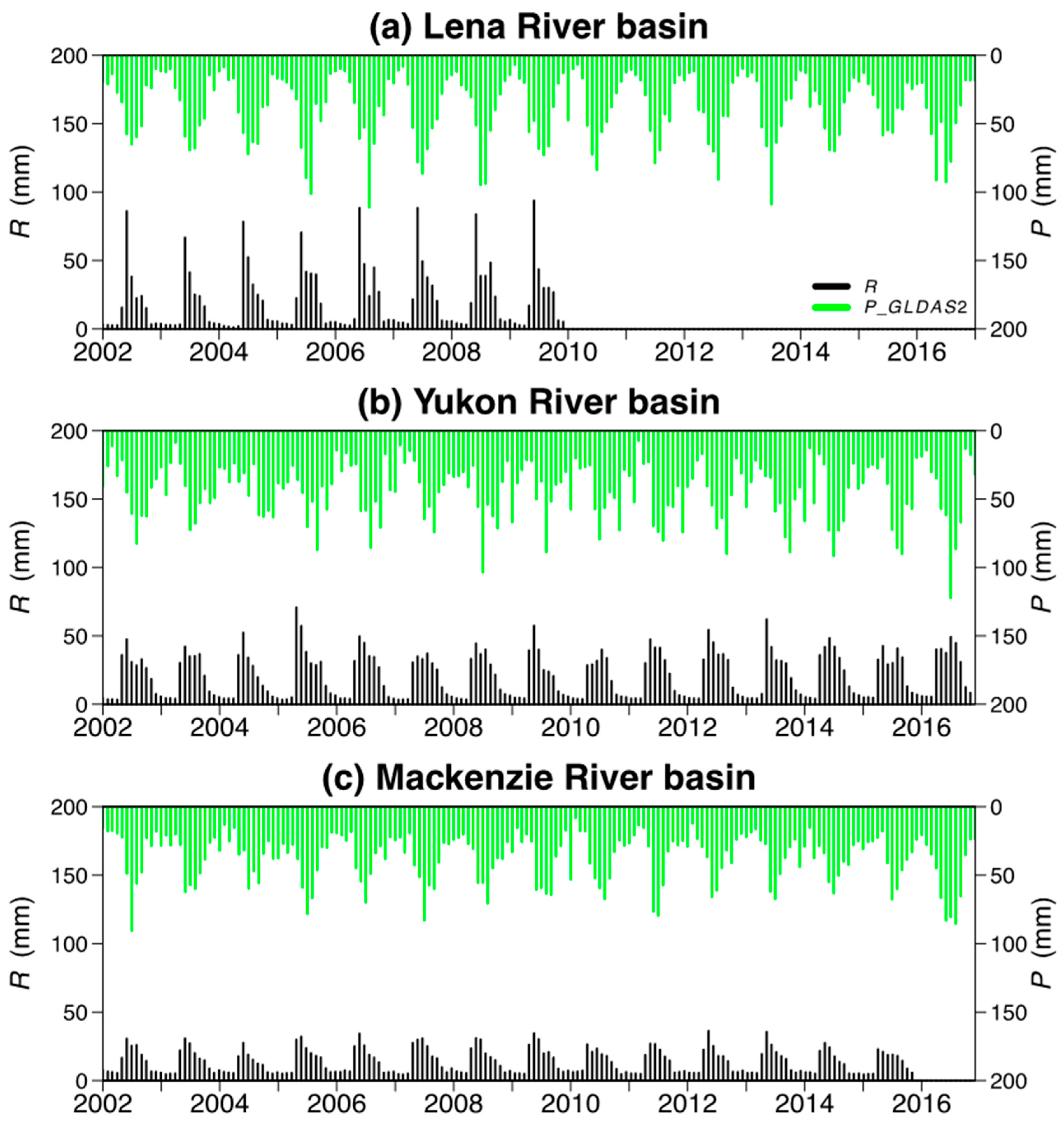
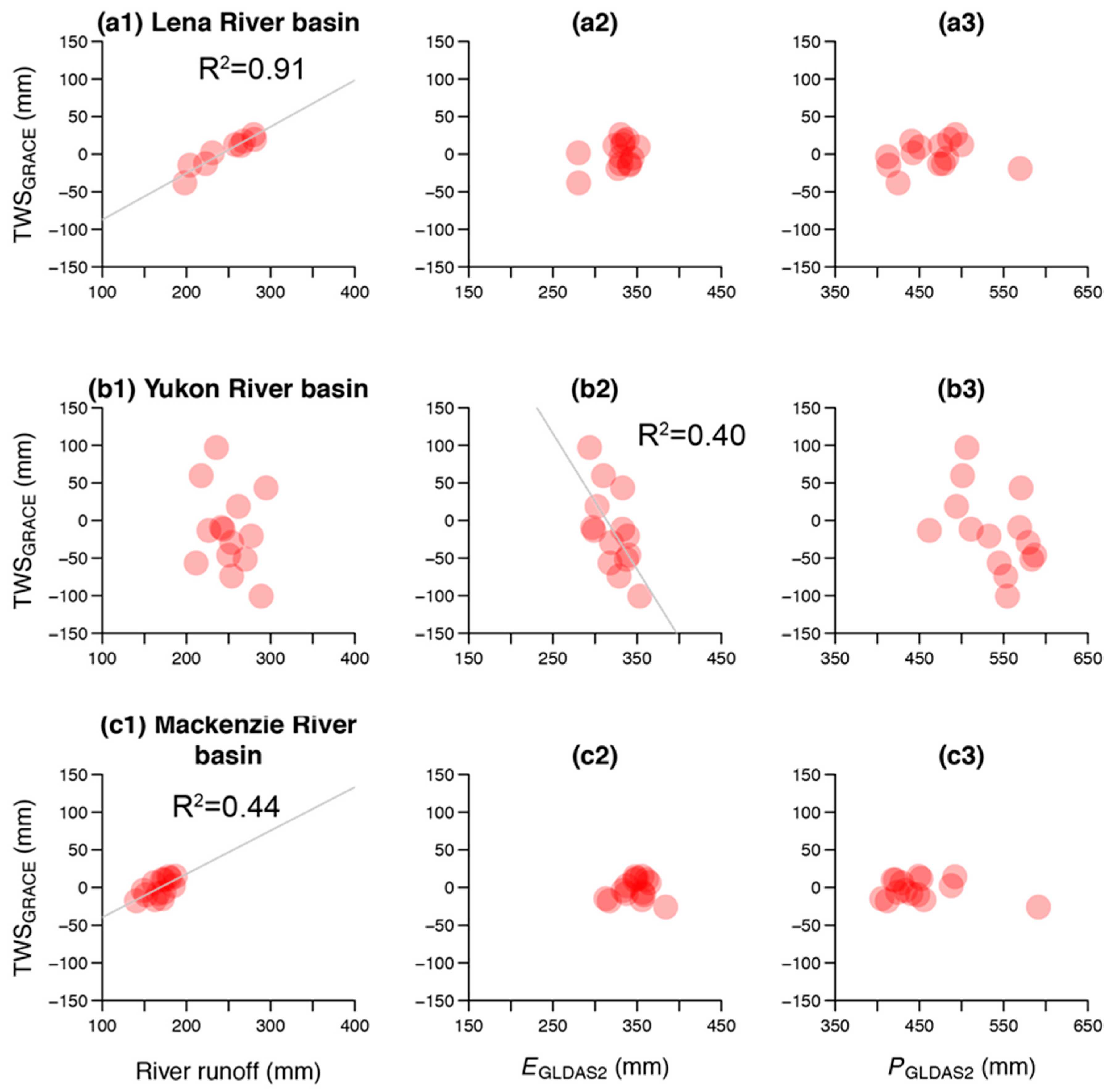
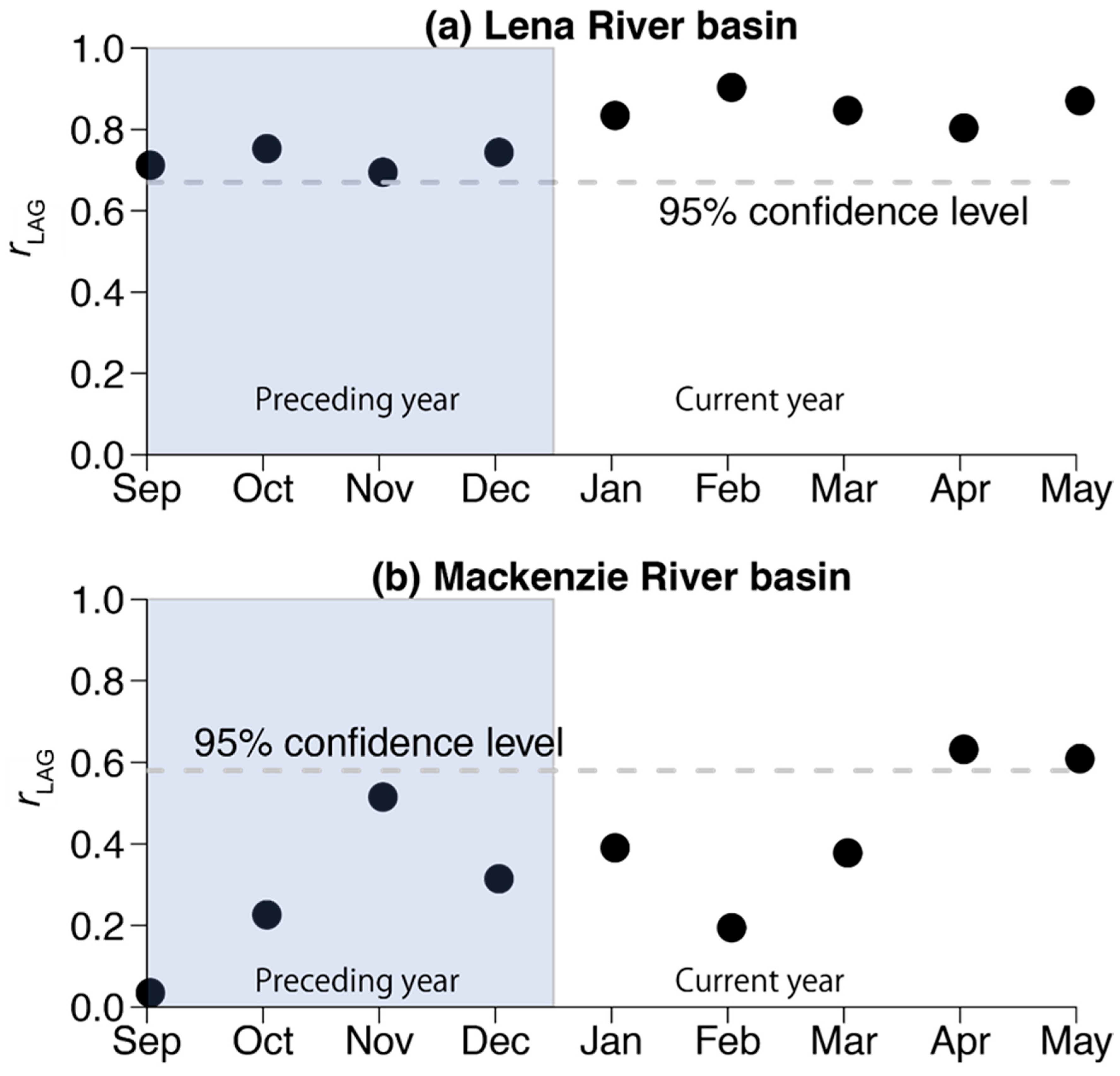
| River Basin | Gauge Station | Drainage Area (km2) | Continuous Permafrost (%) | Discontinuous Permafrost (%) | Tundra Coverage (%) | Forest Coverage (%) |
|---|---|---|---|---|---|---|
| Lena River | Kusur | 2430 103 | 81.6 | 17.6 | 5.0 | 62.0 |
| Yukon River | Pilot | 850 103 | 23.2 | 74.7 | 19.5 | 65.5 |
| Mackenzie River | Arctic Red River | 1790 103 | 20.0 | 39.2 | 33.8 | 61.4 |
| Relationship of Linear Trends | Linear Trend in TWSGRACE Is Positive (0 mm y−1) N = 316 | Linear Trend in TWSGRACE Is Negative (<0 mm y−1) N = 234 |
|---|---|---|
| TWSGRACE & PGLDAS1 | −0.27 | −0.39 |
| TWSGRACE & PGLDAS2 | −0.06 | −0.14 |
| TWSGRACE & EGLDAS1 | 0.50 | −0.21 |
| TWSGRACE & EGLDAS2 | 0.71 | −0.33 |
© 2018 by the authors. Licensee MDPI, Basel, Switzerland. This article is an open access article distributed under the terms and conditions of the Creative Commons Attribution (CC BY) license (http://creativecommons.org/licenses/by/4.0/).
Share and Cite
Suzuki, K.; Matsuo, K.; Yamazaki, D.; Ichii, K.; Iijima, Y.; Papa, F.; Yanagi, Y.; Hiyama, T. Hydrological Variability and Changes in the Arctic Circumpolar Tundra and the Three Largest Pan-Arctic River Basins from 2002 to 2016. Remote Sens. 2018, 10, 402. https://doi.org/10.3390/rs10030402
Suzuki K, Matsuo K, Yamazaki D, Ichii K, Iijima Y, Papa F, Yanagi Y, Hiyama T. Hydrological Variability and Changes in the Arctic Circumpolar Tundra and the Three Largest Pan-Arctic River Basins from 2002 to 2016. Remote Sensing. 2018; 10(3):402. https://doi.org/10.3390/rs10030402
Chicago/Turabian StyleSuzuki, Kazuyoshi, Koji Matsuo, Dai Yamazaki, Kazuhito Ichii, Yoshihiro Iijima, Fabrice Papa, Yuji Yanagi, and Tetsuya Hiyama. 2018. "Hydrological Variability and Changes in the Arctic Circumpolar Tundra and the Three Largest Pan-Arctic River Basins from 2002 to 2016" Remote Sensing 10, no. 3: 402. https://doi.org/10.3390/rs10030402




